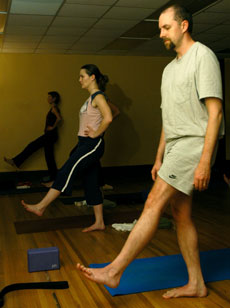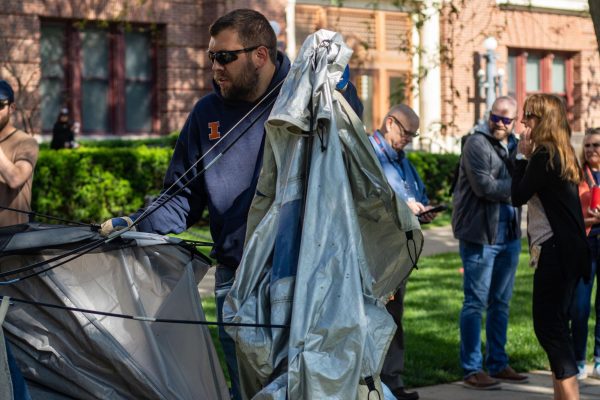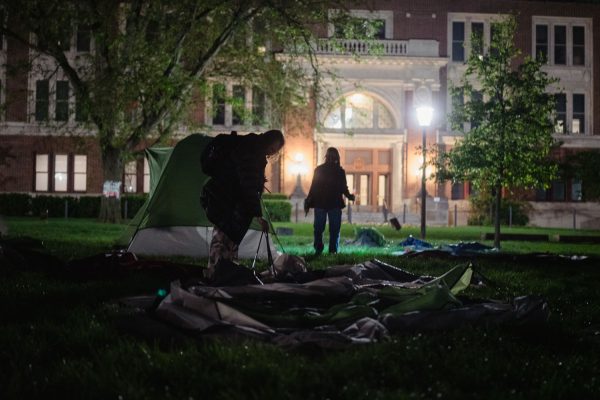Stretching to inner harmony
November 12, 2004
Christie Taube, a 45-year-old seminary, drives 35 minutes from her home in Muncie, Ill., to Champaign several times a week. Her ministry keeps her in Muncie, but it is at the Living Yoga Center in Champaign where she finds solace.
“Yoga is very accepting, you start from where you’re at,” Taube said. “Because people are centered in on their own breath and their own experience, no one is looking at you and no one is judging you.”
Taube has practiced yoga since she was 13 years old. Deb Lister, the director of the Living Yoga Center, did not start practicing yoga until much later, near the time she began competing in triathlons. She wanted to increase her flexibility, strength and balance. Soon, she was hooked. She began teaching yoga classes. Before long, she gave up her job teaching group exercise classes and opened her own yoga studio. Both women plan to practice yoga as long as they can – many yogis practice well into their 80s.
“At my age, it’s time you go with your passion,” Lister said.
Since opening the Living Yoga Center three years ago, Lister said she has seen a dramatic increase in the number of college students taking yoga. There are also more college students taking classes at the studio that have already taken yoga classes. Lister welcomes the diversity.
Get The Daily Illini in your inbox!
The studios are inviting too. One is painted a soft blue, the other a warm yellow. Five small lamps light the rooms, which are big enough for 20 people -although the class size usually ranges between 10-12 adults. The room is sparsely, but uniquely, decorated. Colorful curtains hang from the six large windows.
For many University students, these studios have become a second home.
“A lot of times (former students) send me notes or tell me that this place was one of the reasons they were able to get through college, especially if they were graduate students who were working on their thesis,” Lister said.
Although the benefits for college students are the same as other adults taking yoga, Lister said college students benefit more from the emotional and mental aspects of yoga. By focusing on breathing and other internal cues, students become more in touch with their bodies and many bottled-up emotions. This also allows them to focus on being in the present.
“One major benefit is that you learn to work through struggle – to not bang your head against it but to be patient, breathe and move ‘through’ the struggle,” Lister said. “You can choose to fight with yourself or be patient and continue the work to move forward.”
To reach as many students as possible and accommodate their needs, the Living Yoga Center offers a variety of yoga styles from which students can choose, each providing a different experience. There are the fast-paced, dynamic Flow classes and the slower Hatha classes. The Center also offers Gentle Hatha classes, which are entirely unique.
Many people who take classes discovered yoga at an early age, but Lister said students are never too old to start taking classes.
Champaign resident Dan Brady discovered yoga in college. Decades later, he still practices.
“I was interested in it because it has an inward aspect, and that was interesting,” Brady said. “I suppose I was looking for something like that- in college you just look for things sometimes.”
What he found was an integrated, holistic approach to life. At age 58, he is still learning.
“The body is like an onion; you just have to keep peeling back the layers,” Lister said.
For younger students, this process is easier than that of some of the older participants. Older students have more physical limitations and college students are more open to the experience. The Living Yoga Center caters to college students too – many classes of varying degrees of difficulty are offered at night.
Students are also not required to register for a specific class. Instead, they buy a class card and can come to classes at different times. For example, this fall, the Intro to Yoga class is offered twice on Tuesdays and once on Thursdays. If a student usually goes to the night class on Thursday but cannot make it to class that week, they are more than welcome in one of the Tuesday classes, Lister said.
Lister also encourages students who have never experienced yoga to try it.
“People think to be successful you have to be able to put your foot behind your head. That’s not true,” she said. “The whole point is that you gain flexibility by practicing yoga; you don’t have to be flexible to start practicing.”
Lister also said that students should not be afraid of the spiritual aspects that are associated with yoga – it’s not a religion; it’s a spiritual discipline.
“The difference is that in a religion, you’re looking outside for the divine. In yoga, we look inside,” she said.
Perhaps, that is what keeps Taube coming back, despite her years in the seminary.
“As a pastor of a church, I have to respond to a lot of different situations and a lot of different people wherever they’re at,” Taube said. “My energy has to match people; because of yoga, I am able to stay in my center and not get stressed out.”
In some ways, Lister is the same. She responds to the needs of her students.
Before starting class Tuesday evening she talks to the arriving students. She finds out how they have been and asks if they have any physical discomforts that she should know about. When a student said her wrist was bothering her, Lister explained the best way to modify different postures so the injury does not worsen. Students are also encouraged to modify the night’s lesson too – when they are tired, they take a break. The water cooler in the corner of the room is always accessible.
“Most of my college friends, especially the graduate students, are under so much pressure, yoga gives them a physical release,” Lister said. “It helps them release the physical tension and just gives them some quiet time.
“I know that this sounds very lofty, but you can take the experience of your yoga practice ‘off the mat’ and take it out into your life. That’s why we call it practice – it’s not just relevant to what happens inside a yoga studio – it’s all about how you live your life.”







